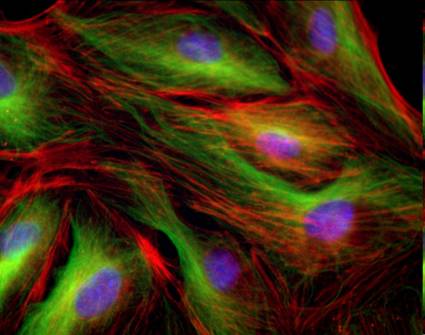Boston University/Redox-sensitive fluorescent dye
From 2007.igem.org
Compound: 5-cyano-2,3-ditolyl tetrazolium chloride (CTC)
Overview: oxidized form is colorless and nonfluorescent; readily reduced via electron transport activity to fluorescent, insoluble CTC-formazan. The formazan accumulates intracellularly (so maybe no need for alginate beads?)
Source:
http://aem.asm.org/cgi/reprint/58/6/1801 Appl Environ Microbiol. 1992 June; 58(6): 1801-1808 Use of a fluorescent redox probe for direct visualization of actively respiring bacteria. G G Rodriguez, D Phipps, K Ishiguro and H F Ridgway Biotechnology Research Department, Orange County Water District, Fountain Valley, California 92728-8300.
The redox dye 5-cyano-2,3-ditolyl tetrazolium chloride (CTC) was employed for direct epifluorescent microscopic enumeration of respiring bacteria in environmental samples. Oxidized CTC is nearly colorless and is nonfluorescent; however, the compound is readily reduced via electron transport activity to fluorescent, insoluble CTC-formazan, which accumulates intracellularly. Bacteria containing CTC-formazan were visualized by epifluorescence microscopy in wet-mount preparations, on polycarbonate membrane filter surfaces, or in biofilms associated with optically opaque surfaces. Counterstaining of CTC-treated samples with the DNA-specific fluorochrome 4',6-diamidino-2-phenylindole allowed enumeration of active and total bacterial subpopulations within the same preparation. Municipal wastewater, groundwater, and seawater samples supplied with exogenous nutrients yielded CTC counts that were generally lower than total 4',6-diamidino-2-phenylindole counts but typically equal to or greater than standard heterotrophic (aerobic) plate counts. In unsupplemented water samples, CTC counts were typically lower than those obtained with the heterotrophic plate count method. Reduction of CTC by planktonic or biofilm-associated bacteria was suppressed by formaldehyde, presumably because of inhibition of electron transport activity and other metabolic processes. Because of their bright red fluorescence (emission maximum, 602 nm), actively respiring bacteria were readily distinguishable from abiotic particles and other background substances, which typically fluoresced at shorter wavelengths. The use of CTC greatly facilitated microscopic detection and enumeration of metabolically active (i.e., respiring) bacteria in environmental samples.
